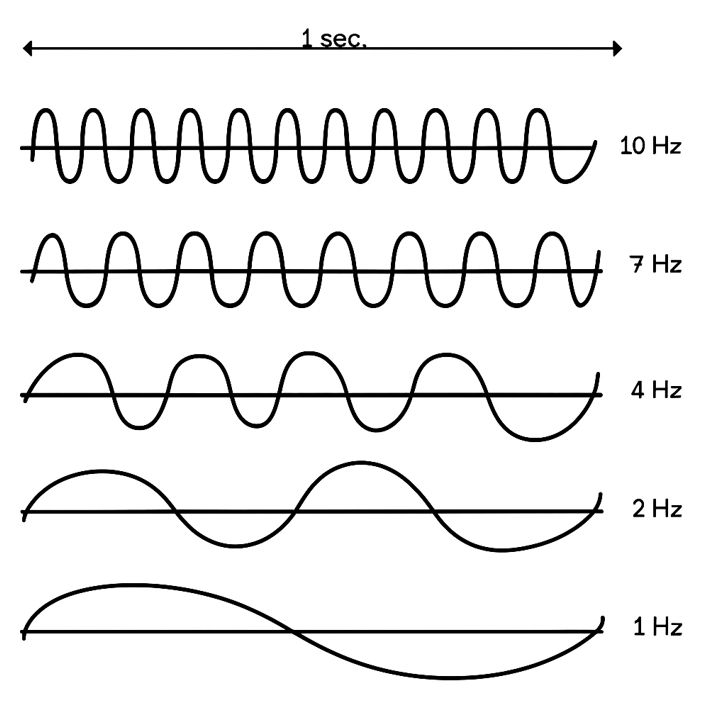Sound Class 9
What is sound ?
→ It is the form of energy that produce sensation of hearing.
Or,
→ Sound is the form of energy like heat energy, kinetic energy, potential energy etc. it causes a sensation of hearing in our ear.
Different types of sound
a. Taking of clock
b. Humming of mosquito
c. Barking of dogs
d. Guitar sound
e. Horn
→ Sound travels in the form of wave.
✦ Wave…
→ It is the mechanism by which energy is transfer from one place to another place without transporting the medium.
Or,
→ It is the periodic disturbance in a medium that transfer from one energy form one particle to another
• Periodic →
Any event which occurs at regular interval of time
• Medium →
Where substance is present like water, air and glass etc.
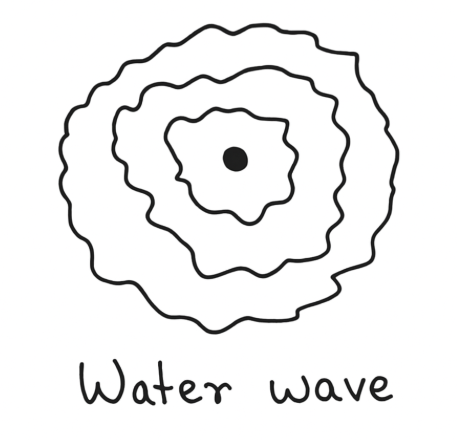
• Vacuum →
Where nothing is not present.
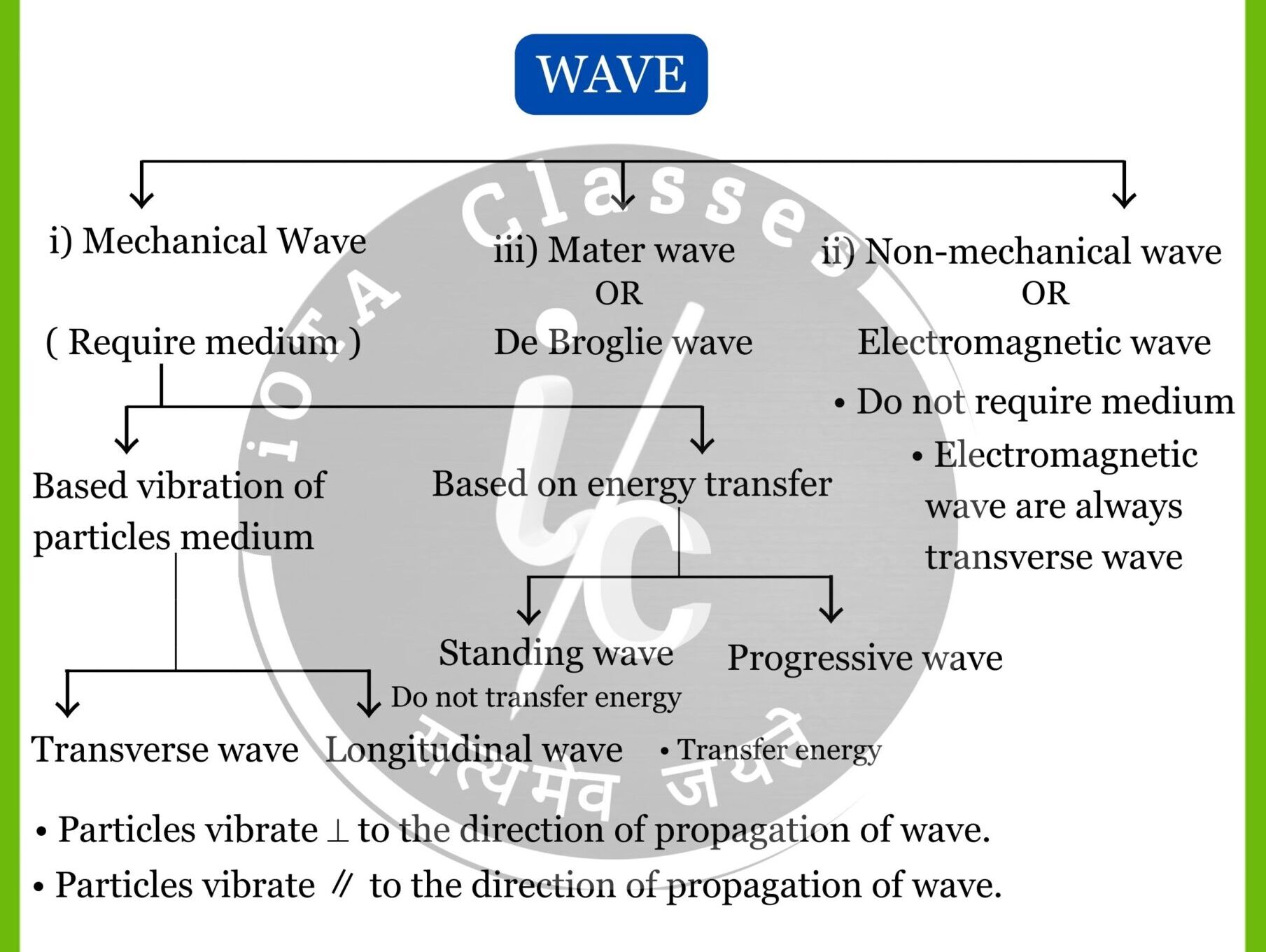
• Mechanical wave
→ Mechanical wave are those wave which require medium to propagate
→ Mechanical wave cannot travel in vacuum.
Example →
Sound wave, wave on surface of water, wave in string etc.
On the basis of vibration of particles of medium mechanical wave divided into two types,
1) Transverse wave
2) Longitudinal wave
1. Transverse wave →
Transverse wave are those wave in which vibration of particles of medium is perpendicular to the direction of propagation of wave.
For example →
Light wave, wave on the surface of water, radio wave.
Seismic S wave →
When earth quake occurs two types of wave are generated P wave and S wave.
P waves are longitudinal while S waves are Transverse wave.
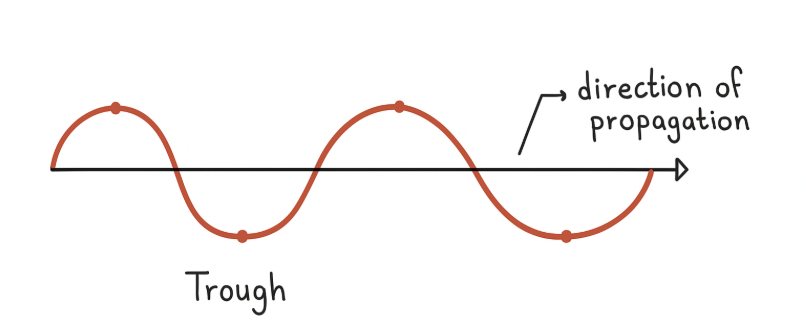
2. Longitudinal wave →
Longitudinal waves are those waves in which vibration particles of medium is parallel to the direction of the propagation of the wave.
Example:- Sound waves, seismic P waves, ultra sound wave
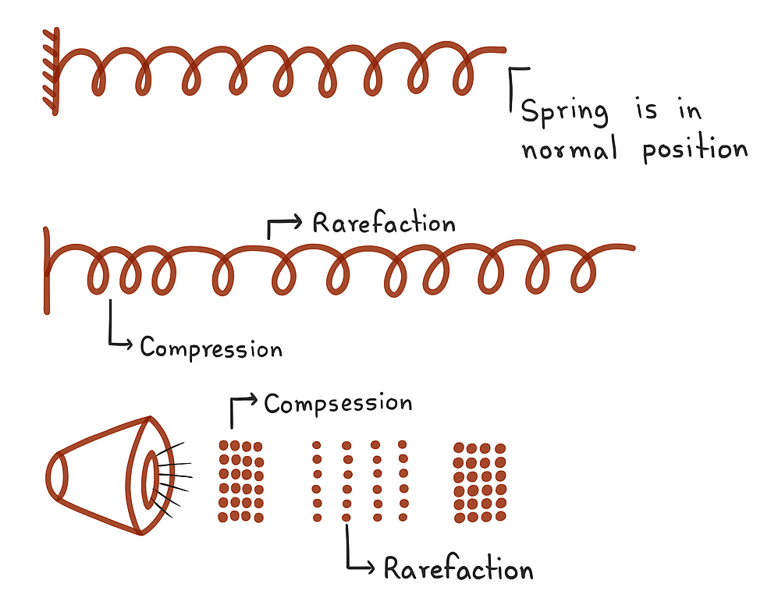
On the basis of energy transfer.
1. Standing wares / stationary waves
2. Progressive waves / Travelling waves
1. Standing waves →
When two progressive wave of same amplitude, same time period and same speed are travelling in opposite direction than resultant wave which does appear to travel is called standing wave.
→ Waves which do not transfer energy.
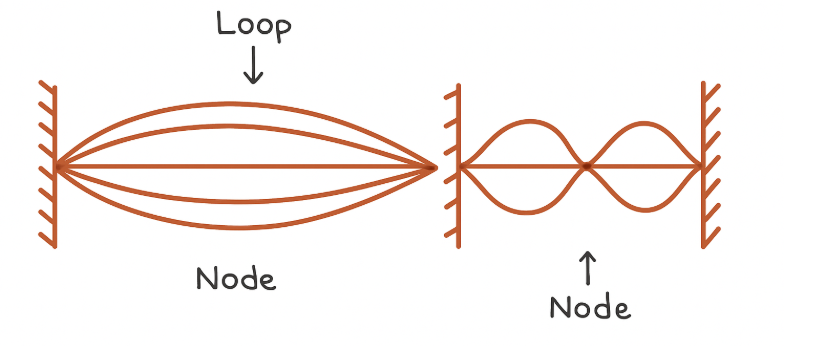
Example →
Two people shaking either end of a jump rope.
2. Progressive wave →
A wave which travels continually in a medium in the same direction without a change in its amplitude is called a travelling wave or progressive wave.
→ Wave which transfer energy.
Example →
Water wave, Sound wave.
→ Progressive wave can be longitudinal, transverse wave or both.
• Non-mechanical wave / Electromagnetic wave
→ Electromagnetic wave or Electromagnetic waves are waves that are created as a result of vibration between an electric and a magnetic field.
→ In other words electromagnetic waves are composed of oscillating magnetic and electric field.
→ Electromagnetic wave do not required medium to travel.
Example →
Radio waves, X-rays, gamma rays, UV rays.
• Note →
Electromagnetic waves are always transverse wave.
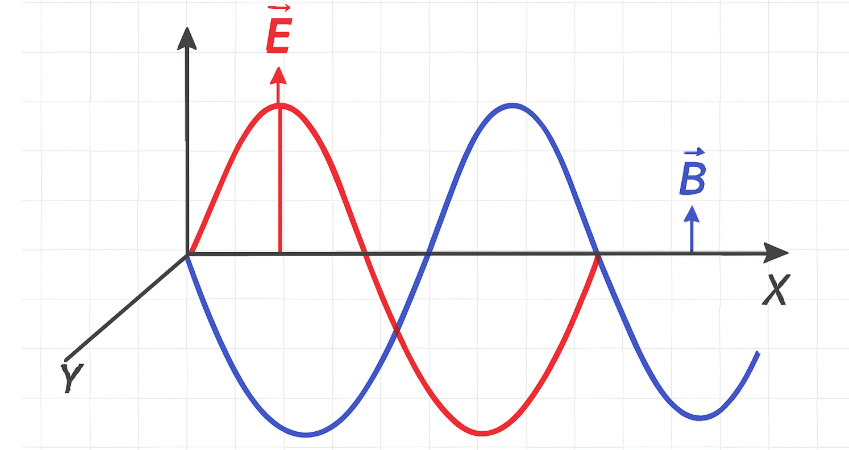
3. Matter waves / De-Broglie waves →
Particles like electron at very high speed which is comparable to the speed of light behaves like a wave, these waves which are associated with the moving particles of matters are called De-Broglie waves or matter waves.
• Note →
Dual nature of matter was proposed by De-Broglie in 1924, It was experimentally verified by Davisson and German by Diffraction experiment.
* Crest and Trough
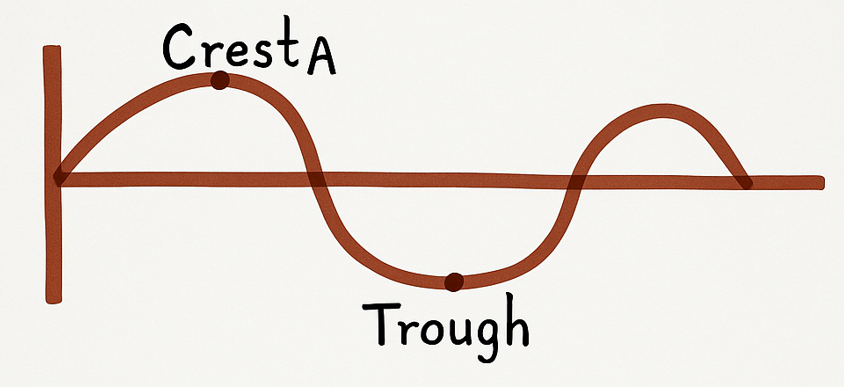
• Crest →
It is a point on surface wave that exhibits maximum positive all upward displacement from un disturb (mean position).
→ A point is crest.
• Trough →
It is a point on surface wave that exhibits maximum negative or downward displacement from un disturb (mean position).
→ B point is Trough.
# Compression and Rarefaction
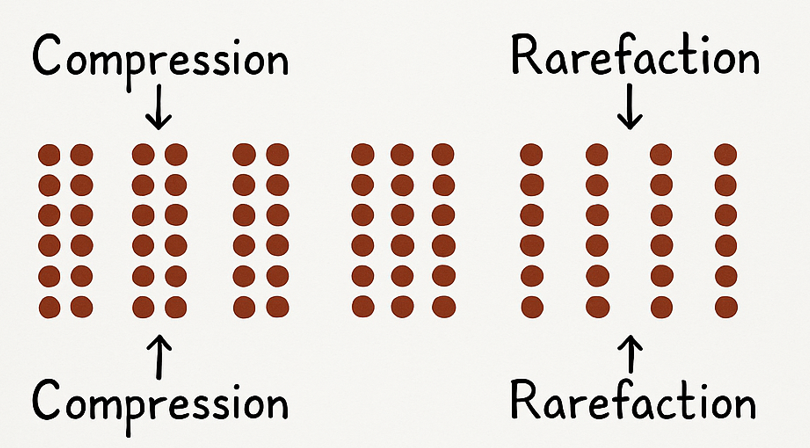
• Compression →
Compression is a point where the particles of medium are closer density is maximum.
• Rarefaction →
Rarefaction is a point where the particles of medium are farther apart or density is minimum.
• Note →
Transverse waves propagate in the form of crest and trough where as longitudinal propagate in the form of compression and rarefaction.
• General characteristics of wave
1. Wavelength →
Lambda (λ)
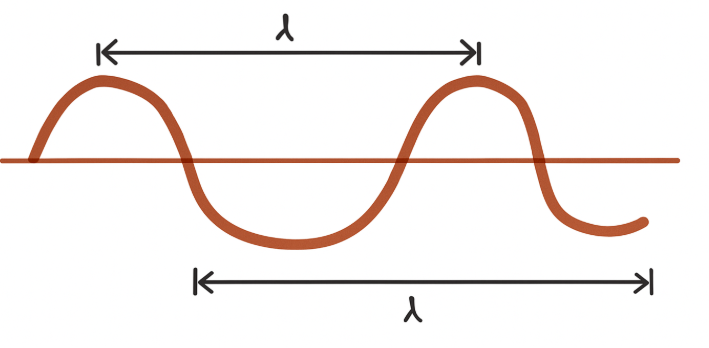
→ It is simply the length of one complete wave cycle.
→ The distance between two successive crest or trough of a wave is defined as its wavelength.
→ It is distance from a point of one wave to corresponding point on the next wave.
→ Its SI unit is meter (m).
→ It is denoted by lambda (λ).
Frequency →

→ No. of wave passes through a point in 1 sec.
Or,
→ It is the no. of complete cycles of wave passing a point in unit time.
• SI unit of frequency is Hertz (Hz).
• Note →
Frequency is inversely proportional to the wave length.
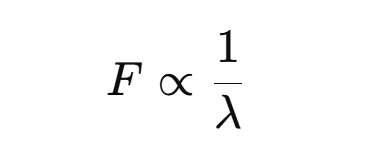
3. Time Period →
(T)
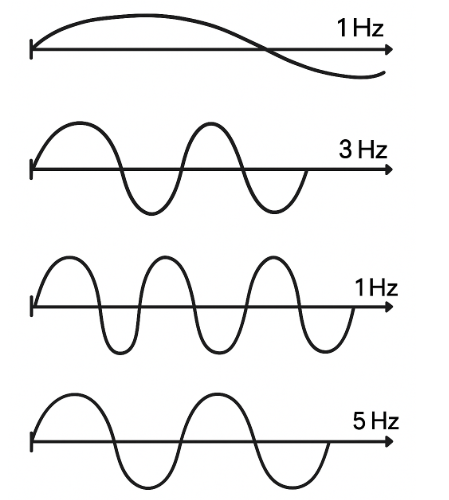
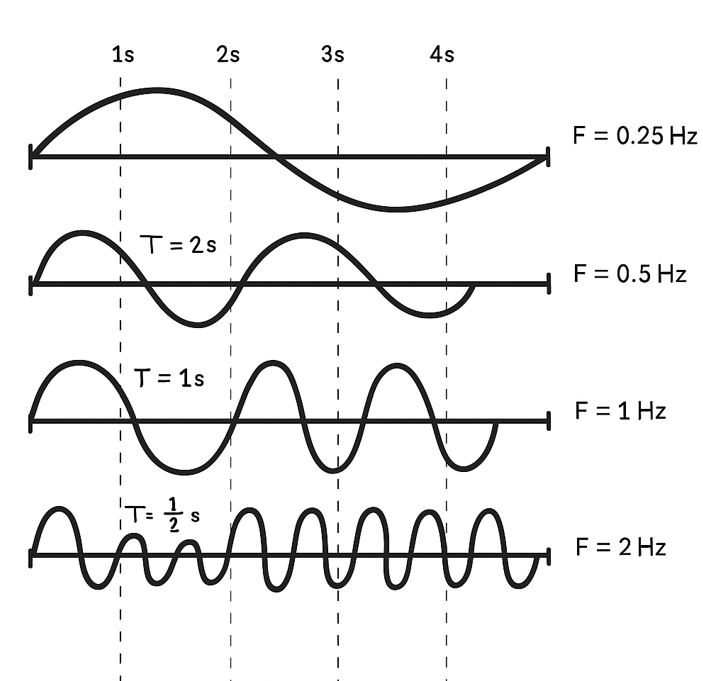
➝ Time required to complete one wave cycle is called time period.
➝ It is denoted by ‘T’.
➝ And its SI unit is sec.
★ Note →
Time period is inversely proportional to frequency.

4. Wave Speed
• Wave speed or wave velocity is the distance traveled by a wave per unit time.
• As we known that
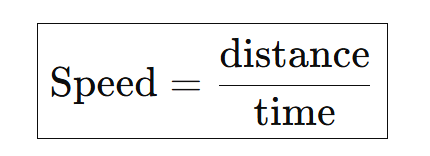
Here distance is wavelength (λ) and time is time period ().
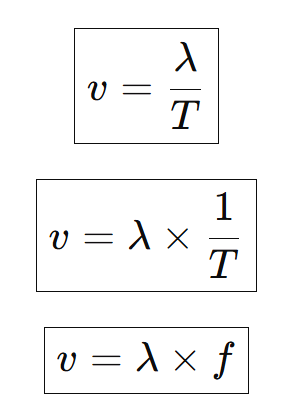
5. Amplitude →
(A)
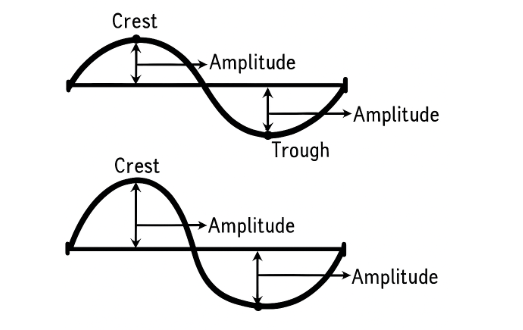
• It is the maximum displacement of wave from undisturbed position.
• It is the distance from crest to the rest position or from trough to mean position.
• SI unit of Amplitude is meter (m).
⭐ Main characteristics of Sound
- Loudness
- Pitch
- Quality or Timbre
- Intensity
1. Loudness →
• Two sound can be differentiated which is produced from the same source and same instrument but different in level is called loudness.
• Loudness of sound depends on Amplitude and distance from the source, density of the medium, surface area of a vibrating body and presence of resonating body.
OR
• Loudness is the characteristic of the sound and it is the degree of sensation of sound which means two sound can be differentiated which is produced from the same source or the same instrument but different in level, is called loudness.
1. Amplitude
• Loudness of sound is depend upon the amplitude, if the amplitude is high or the displacement of amplitude is more than the sound will be more loud.
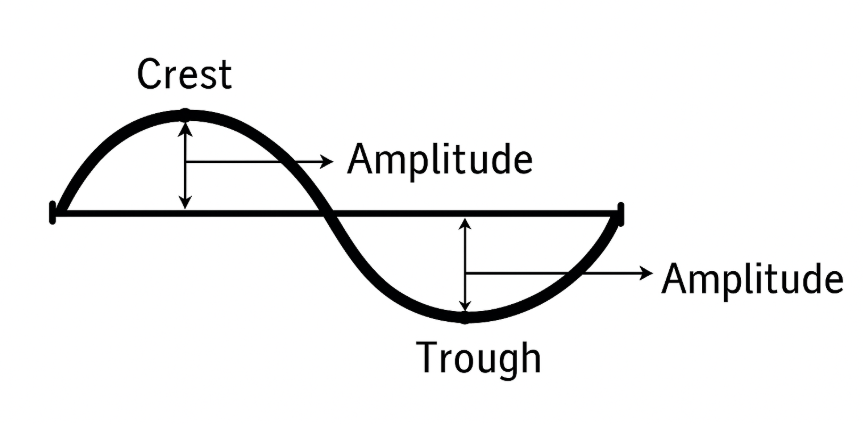
• The loudness of sound is directly proportional to the square of Amplitude of vibration.
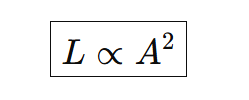
(a) If the amplitude of vibration is double, than the loudness will become 4 times.
(b) If the amplitude of vibration is half, than the loudness will become 1/4.
2. Distance from the source
• The loudness of sound is inversely proportional to square of distance from the source

3. Density of medium
• Loudness of sound will be more if density is more.
4. Surface area of vibrating body
• Loudness of sound will be more if the surface area of vibrating body is more.
5. Presence of resonating body
• Loudness of sound will be increased when any other object catches the frequency of the vibrating body and produces the sound.
• Loudness of sound is measured in decibel (dB) or phor.
Different types of Loudness of sound coming from various source
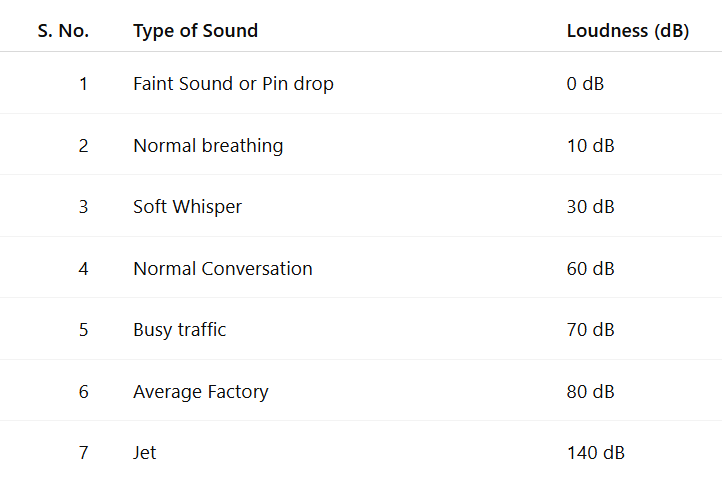
• Smallest sound is Pin drop or 0 dB.
• Noise starts from above 120 dB.
• Loudness is subjective quantity.
• Intensity is objective quantity.
2. Pitch →
Pitch is that characteristics of sound by which we can distinguish between the different sound of the same loudness but different frequency. It means it determines the shrillness or deepness of sound, graveness of sound.
• Pitch of the sound depends on the frequency of vibration.
• The pitch of the sound is directly proportional to the frequency.
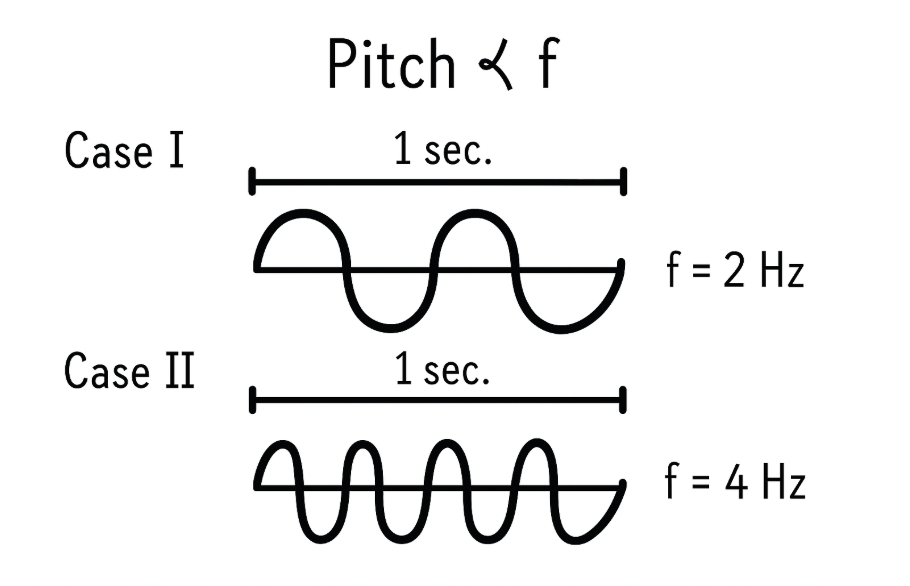
• Case I and Case II both are waves disturbance, both have same amplitude. Therefore loudness of sound will be same, but frequency is different, there pitch will be different.
• In Case I it has low frequency therefore sound will be deep and grave. Which is found in case of men voice, But in Case II frequency is high, therefore it will produced shrill sound which is found in women voice.
3. Quality or Timbre →
• Quality is the property by which one can distinguish between two different sound of same pitch and loudness.
Or,
• Two sound of same loudness and same pitch but from different instrument can be distinguish.

• Amplitude is same, Loudness is same, frequency is same, Pitch is same but wave formed in different quality, Or we can say that quality of sound depends upon shape of sound wave.
4. Intensity →
It is the no. of sound wave passing one meter square area in one second is called intensity.
Or,
Energy passes from unit area in unit time, and this area should perpendicular to the direction of energy is called intensity.

Energy of Sound
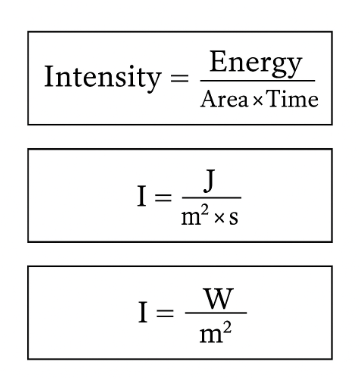
• How Sound is Produced?
Sound is produced by vibrating objects.
[ Vibration or Oscillation ]
➝ The rapid to and fro movement of an object about a fixed position is called vibration or oscillation.
➝ When an object moves backwards and forwards (to and fro) rapidly, then object is called vibrating object and whenever we hear a sound then there must be some object vibrating to produce that sound.
➝ Energy required to set an object vibrate and produces sound.
Note →
(i) Sound is produced due to the vibration of object
(ii) The motion of materials or objects causes vibration.
(iii) Vibration is a kind of rapid to and fro motion of an object from a central position.
Example →
(a) A stretched rubber band when plucked vibrates and produces sound.
(b) Some sounds made by musicals instrument like Flute, Table, Harmonium, Guitar etc. because of vibration.
(c) When a spoon is bitten in the top of various filled glasses then various sound will be produced.
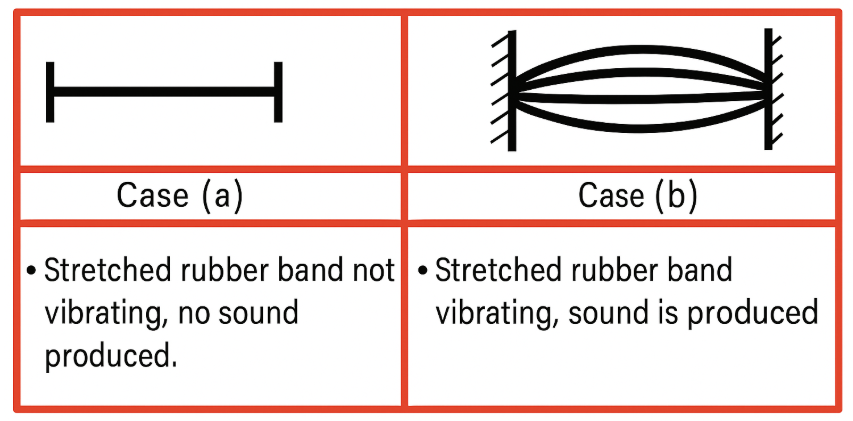
Question 1. What produces sound?
Answer: Vibrations, without vibration sound cannot be produced.
Note →
Vibrations and Oscillations are same thing.
→ Vibration occurs at high frequency (Intensity).
→ Oscillation has very low frequency therefore oscillation cannot produced sound.
Propagation of Sound
→ The travelling of sound is called propagation of sound.
→ Sound is propagated by the to and fro motion of particles of the medium.
→ When an object vibrates backward and forth in air then the molecules of air close to this object and start vibrating back and forth with the same frequency. These vibrating air molecules pass on their motion to the next layer of the molecules. Due to which they also starts vibrating back and forth. This process goes on and on. When the vibrating air molecules fall on our air, then air feels these vibration as sound.
Factors affecting the speed of Sound.
→ The speed of sound tells us the rate at which sound travels from the sound producing body to our air.
Factors affecting the speed of sound,
- The speed of sound depends on the nature of material or medium through which it travels. Sound travels slowest in gases, faster in Liquid and fastest in Solid.
- The speed of sound depends on the temperature. As the temperature of air rises the speed of sound in it increases.
- The speed of sound depends on the humidity of air. As the humidity of air increases, speed of sound increases.
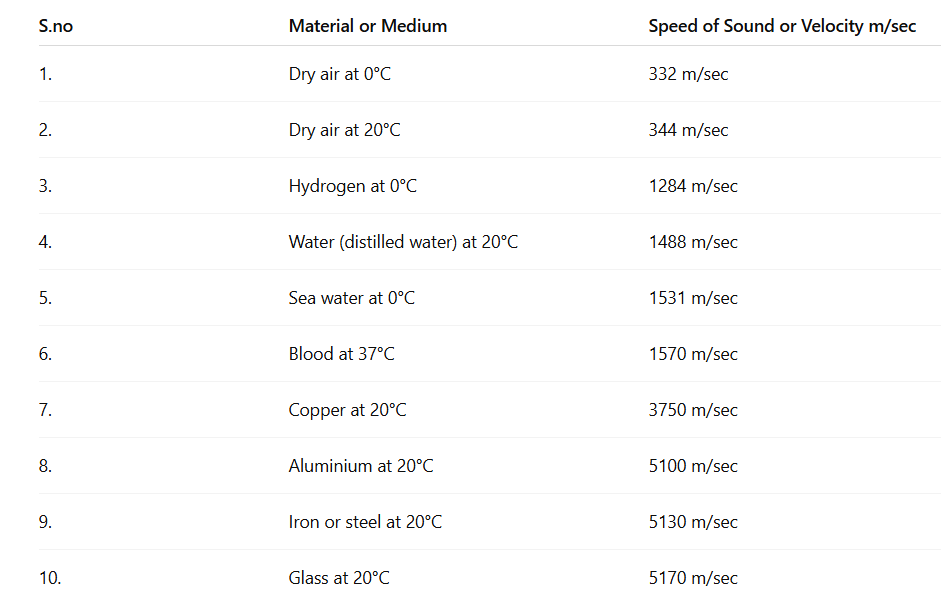
Note →
(i) Sound travels a distance of 344 m in 1 sec through air at the room temperature.
(ii) Sound travels about 5 times faster in water than in air.
(iii) Sound travels about 15 times faster in Iron or Steel than in air.
Reflection of Sound
→ The bouncing back of sound when it strikes a hard surface is called reflection of sound.
For example →
Sound is reflected well from hard surfaces like a wall, a metal sheet, hardwood and a cliff.
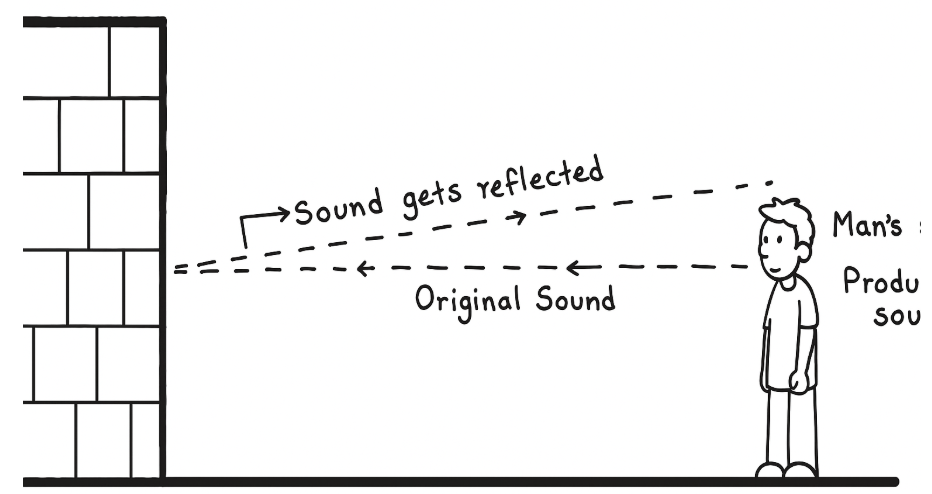
→ The laws of reflection of light are obeyed during the reflection of sound.
The law of reflection of Sound
- The incident sound wave, the reflected sound wave, and the normal at the point of incidence, all lies in the same plane.
- The angle of reflection of sound is always equal to the angle of incidence of sound.
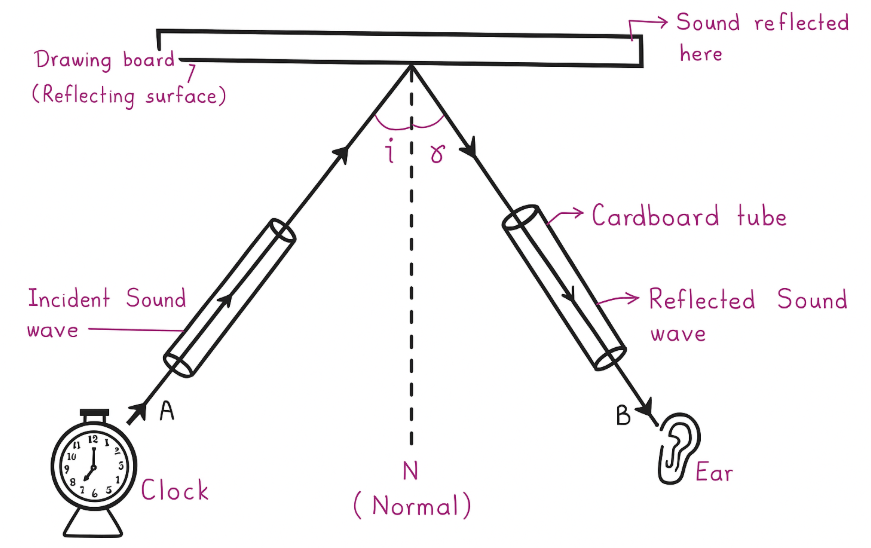
Here, i = angle of incident
r = Angle of reflection
N = Normal
Audible and Inaudible Sound
→ The range of frequency from 20 Hz to 20000 Hz is known as the frequency range of hearing in humans.
→ The sound which are able to hear is called audible sound.
Note →
→ The sounds of frequencies lower than 20 Hz are known as infrasonic sound (or just infra sound).
→ Infrasonic sound cannot be heired by human beings.
→ Whales and Elephant produces infrasonic sound.
→ Sounds of frequency above 20000 Hz are called ultrasonic sound. Dolphins, Bats, Porpoises, moths of certain families and rats can produce ultrasonic sound.
Echo →
Phenomenon of hearing back our own sound is called an echo.
→ It is due to successive reflection of sound waves from the surfaces or obstacles of a large size.
→ To hear an echo there must be a time gap of 0.1 sec. in original sound and the reflected sound.
Necessary condition for the formation of an Echo
→ The re are two conditions to experiences the Echo of sound.
→ Time gap between the sound must come back to the person after 0.1 sec.
→ For above condition the reflecting surface must be at a minimum distance of 17.2 m. it also depends on temperature.
Reverberation →
Persistance of the sound wave for a long time because of repeated (multiple) reflection of sound are called reverberation.
→ In big concert or halls, due to the reverberation sound may become blurred and distorted to be heired.
→ To avoid reverberation soft sound absorbent materials such as curtains, plants, Fiber Compressed fiberboard, carpets, etc. are used in the auditorium.
Applications of Ultra Sound
→ These are the sound waves having frequency more than 20000 Hz. Due to the high frequency ultra sound is associated with more energy and can penetrate up to a large extent. these character is tics of ultra sound makes it very useful for many purposes.
- They are used to detect any deformities (flaws, cracks) in metal brokers or sheets.
- They are used to clean the hard to reach parts of machinery like spiral tub tubes.
- Bats use ultra sound waves to find their prey. Bats produce high pitched ultrasonic squeaks. These squeaks are reflected by object such as praise preys and are returned to the bats ear. This allows a bat to know the distance of its prey.
- Dolphins use ultra sound to find fish and to detect sharks that may attack them.
- Ultra sound waves are commonly used for medical diagnosis and therapy and also as a surgical tool.
- They find their applications in breaking stones found in the kidneys into fine grains
• Echocardiography →
These waves are use to reflect the action of heart and its images are form. This technique is called echocardiography.
• Ultrasonography →
The techniques of obtaining pictures of internal organs of the body by using echoes of ultrasound waves is called ultrasonography.
Sonar →
So → Sound
n → Navigation
a → And
r → Ranging
→ Sonar stands for sound navigation and ranging.
→ It is a device which is used to find distance, direction and speed of under water objects like water hills, valleys, icebergs, submarines, sunken ships, etc.
→ Sonar consists of a transmitter and a receptor or a detector and is installed at the bottom of the ship.
→ The transmitter produces and transmits ultrasonic wave. These waves travel through sea water and after striking the objects on the bottom of sea, are reflected back and received and recorded by the detector.
→ The SONAR device major measures the time taken by ultra sound waves to travel from ship to sea bed.
→ Let the time travel between transmission and reception of ultra sound signals is ‘t’.
Speed of sound through sea water is ‘v’.
→ Total distance travelled is ‘2d’, then

→ This method of measuring distance is also known as echo ranging.
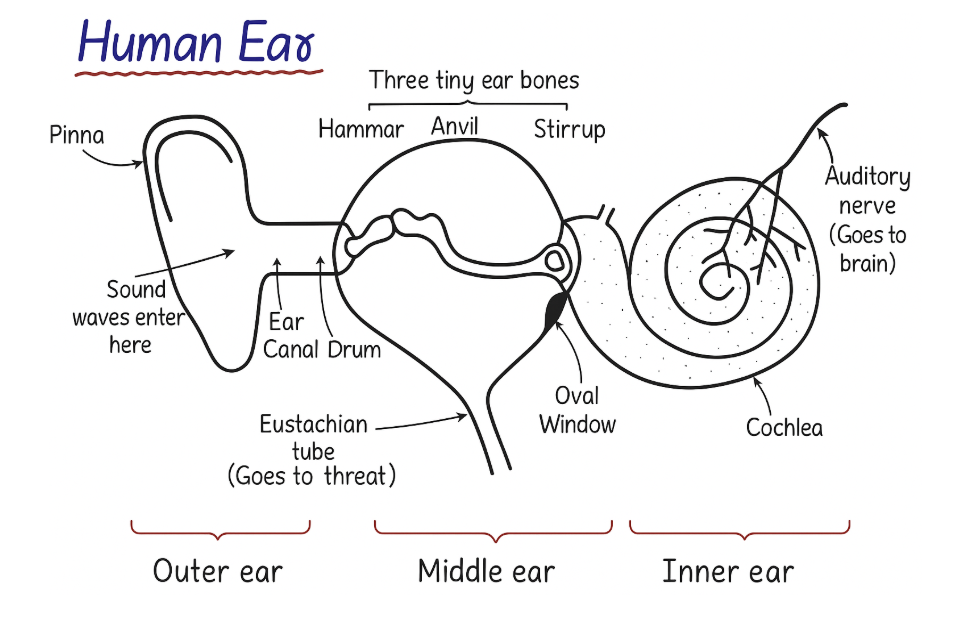
Human Ear…
Structure of Human ear.
↳ The human ear can be divided into three main part (i) Outer ear, (ii) Middle ear, (iii) Inner ear
(i) Outer ear →
The outer ear is outside the body and is also called pinna.
↳ It extends into ear canals. Ear canal is filled will ear.
(ii) Middle ear →
The middle ear is composed of the ear drum or Tympanum (It is an elastic membrane, circular in shape) and and bone ossicles. There are three bone ossicles, namely the hammer, anvil and the stirrup.
(iii) Inner ear →
Inner ear is composed of a cochlea and three semicircular canals. The cochlea is filled with fluid, that moves in response to the sound wave which are then converted into electrical impulses that travel to the brain.
Working of Human Ear…
↳ The outer ear called pinna collects the sound wave. Sound wave passes through the ear canal to a thin membrane called ear drum. The ear drum vibrates. The vibration are amplified by the three bones of the middle ear called hammer, anvil, stirrup. The middle ear bones which in turned moves the steps in the oval window of cochlea, and it transmits the sound weave wave to the inner ear in the near inner sound waves and are converted into electrical impulse by the cochlea and send the brain through the auditory nerve the brain interprets the single & sound.
Reflection of Light
Official Website- Physics Wallah
iOTA CLASSES has been working for the last 6 years at youtube ( online mode) but from last year ( 2024) we are running both online and offline,
With the cooperation of students , parents , our colleagues and team, we have gained satisfactory results,
And working more enthusiastically for the better aspirations. image of 2024 class 10th result [CBSE and BSEB( ENG. Med)]

